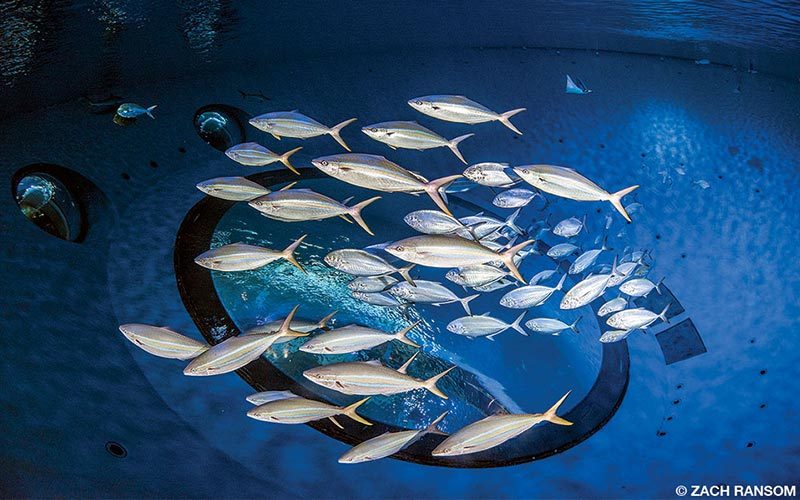There’s something fishy about the newest residents of downtown Miami, Fla. Scalloped hammerhead sharks, devil rays, schooling jacks and iridescent jellies are just a few of the inhabitants that now reside at a prime piece of real estate overlooking Biscayne Bay. Located in Miami’s waterfront Museum Park neighborhood, the Phillip and Patricia Frost Museum of Science sits in the midst of South Florida’s urban sprawl. In a different world, this property might have housed a luxury condominium complex, but instead Frost Science’s 250,000-square-foot, four-building campus combines an aquarium, a planetarium and a variety of hands-on science exhibits.
Working toward a Leadership in Energy and Environmental Design (LEED) Gold Certification, the state-of-the-art facility boasts light-emitting diode (LED) lighting and increased building insulation to maximize energy efficiency. The most innovative aspect of Frost Science, however, has nothing to do with its green building design; that distinction belongs to its potential to inspire an interest in science, conservation and marine life. The concept of using an aquarium as a platform for environmental education is not new, but given Miami’s location on a narrow strip of land between the Atlantic Ocean and the Everglades, Frost Science’s ability to communicate ocean awareness is not just a perk — it’s a necessity.
The aquarium’s goal is simple: get people interested in science and marine life. I visited the aquarium at Frost Science on a sunny summer afternoon to observe how this is accomplished.

My tour began on the Vista level, an open-air floor on the top deck of the building, which is where I got my first glimpse of the aquarium’s centerpiece, the Gulf Stream Aquarium, designed to pay homage to one of the most powerful ocean currents on Earth. How does one recreate in the middle of a city the wide-open, ever-changing environment that is the Gulf Stream? Frost Science has done it by filling what is essentially a giant martini glass with 500,000 gallons of salt water and then adding powerful, pelagic swimmers such as mahi-mahi, little tunny, scalloped hammerheads and devil rays.
The exhibit is especially unique because it has no vertical walls; instead the aquarium is conical, allowing its streamlined pelagic inhabitants to move uninterrupted as they cut through the water. The staff can adjust the direction of the current within the exhibit, which is a good source of enrichment for the animals, explained Andy Dehart, vice president of animal husbandry. The man-made current also helps to support the feeding mechanisms of the Gulf Stream Aquarium inhabitants. One animal who benefits from this is the devil ray, a filter feeder who strains suspended food particles out of the water.

Pelagic species such as the animals that reside in the Gulf Stream Aquarium are uncommon sightings for most scuba divers. As a diver who experiences coral reef and nearshore environments firsthand on a regular basis, I was stunned by this microcosm of the open ocean. Dehart explained that as an environmental facility in Miami, the Frost Science team felt as though it were critical for them to explain the importance of the Gulf Stream and its influence on weather patterns and to demonstrate how South Florida’s marine habitats are interconnected. Although the density of animals is far greater in the Gulf Stream Aquarium than in the open ocean, the dynamic and far-reaching nature of the Gulf Stream current is conveyed in the educational signage surrounding the exhibit, which covers topics including sustainable seafood, shark conservation and global ocean currents.
Continuing across the Vista level, the interconnectedness of South Florida’s marine habitats is depicted through coral reef, mangrove forest and sandy shore exhibits as well as in exhibits displaying the unique and fragile ecosystems of Florida Bay and the Everglades.
Animal Ambassadors
Seeing an animal up close for the first time and feeling a connection with another living creature is an experience that’s meaningful and unforgettable to many people. Dehart recalled seeing a Caribbean reef shark for the first time as a 6-year-old snorkeling with his dad at Looe Key National Marine Sanctuary. “If you really want the experience, it’s out there in the ocean. Go do it,” Dehart suggested. But he knows that many people will never get the chance to experience the ocean firsthand, and for those people Frost Science provides a rare opportunity to observe and learn from marine life.
Dehart and senior aquarist Zach Ransom are two members of the 23-person animal husbandry staff at Frost Science, and all of them aim to inspire the public to care about the ocean. It’s clear that the Frost Science team is passionate about their field and truly care about the animals that call Frost Science home. They care so much, in fact, that they recently released a tiger shark who was previously a resident of the Gulf Stream Aquarium. After observing that the animal was not acclimating well, the Frost Science team decided to release the shark, with approval from the National Oceanic and Atmospheric Administration (NOAA). Tiger sharks, which are extremely rare in aquariums, would have been a big draw for the Gulf Stream Aquarium.

After admiring the Vista’s many habitats, I made my way down to the Dive, the second level of the aquarium. This level features numerous exhibits paired with interpretive signage and hands-on activities, including an invertebrate encounter exhibit cleverly named the Dive Bar. The Live Tropical Pacific Reef habitat is a beautiful showcase of tropical Pacific fish species, and the Live Corals of the Florida Reef habitat has many familiar species such as blue tangs and French angelfish.
One particularly interesting and relevant display on the Dive level presents exotic and invasive species. According to the Florida Fish and Wildlife Conservation Commission, more than 500 nonnative, or exotic, species of fish and wildlife have been reported in Florida. The exhibit, which has information about various exotic species, also has several invasive lionfish that Frost Science staff removed from the South Florida area. The star of the exotic species exhibit, however, is a charismatic onespot rabbitfish — a bright yellow fish with a pointed snout that was caught locally last fall through a partnership with the U.S. Geological Survey and the Key Largo-based nonprofit Reef Environmental Education Foundation (REEF). The fish, which was reported to REEF through an online sightings forum, was removed from the water preemptively to prevent the spread of invasive species. The rabbitfish now flits about the exotic species exhibit at Frost Science, serving as a cautionary tale for visitors and an excellent educational tool.
Also on the Dive level is a multiplayer game designed to educate visitors about sustainable fishing practices. Each player controls his or her own fishing boat on a touchscreen, trying to “catch” the most fish (and therefore make the most money) while attempting to fish in an environmentally conscious manner. The game begins by prompting each player to select a fishing method. I opted for lines over nets and tried my best to steer my boat away from species that were indicated to be overfished. Halfway through the game, a notification popped up asking if I’d like to vote in favor of establishing a season for black grouper. I voted yes and felt satisfied that I had made an environmentally friendly choice, but shortly afterward I was not able to maneuver my digital fishing vessel dexterously enough to avoid catching a sea turtle. Horrified, I spent the rest of the game harvesting mahi-mahi in a small area on the game map, far away from any endangered species.

The complexities of the commercial-fishing industry involve much more than simply selecting lines or nets and then using a touchscreen to chase digital schools of mahi-mahi, but the game is a fun, hands-on way to demonstrate how overfishing certain species can have cascading effects on other marine life and to make consumers aware of the importance of making responsible seafood choices.
Interactive activities and up-close animal encounters are what make Frost Science successful at sparking an interest in science and conservation. Experiences like these may not be the same as Dehart’s wild shark sighting as a child at Looe Key, but having the opportunity to see and learn from an animal ambassador at a place like Frost Science can lead to further engagement in the future. Frost Science is on track to surpass 1 million visitors in its first year. Quantifying revenue in ticket sales is easy, but it’s nearly impossible to estimate the value of creating interest and support for conservation. Imagine the difference that 1 million people who care about sustainable fishing or shark conservation could make for our ocean.
My visit to Frost Science ended on the bottom floor, called the Deep. After first passing a virtual-reality screen depicting a simulated marine mammal interaction, complete with sound, and then observing several species of ghostly jellies drifting through the water in three separate receptacles, I was finally under the oculus, a 31-foot lens that forms the bottom half of the Gulf Stream Aquarium. Standing under the oculus as the South Florida sunlight shone through the water while sharks, rays and fish cruised overhead, I was reminded of a view that’s normally enjoyed only by divers.
Frost Science can give a rewarding glimpse of the underwater world to those who have not experienced what it’s like to be there firsthand, and I hope it will inspire appreciation for and awe of these fragile marine environments.
| © Alert Diver — Q4 2017 |